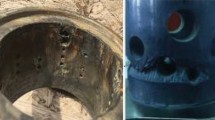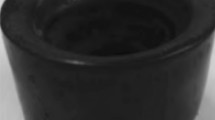Abstract
The throttle valve is a key piece of equipment in natural gas extraction, playing the role of throttling and depressurizing high-pressure natural gas. Because of its the special structure, sand-carrying high-pressure natural gas will flow through the tiny overflow surface between the valve body and the spool at high speed, which will inevitably cause erode the throttle valve and thus cause its failure. Therefore, to study the erosion of angle throttle valves by sand-carrying natural gas, we designed an indoor erosion experiment to determine the erosion model of 12Cr13 and applied an erosion model in an angle throttle valve erosion simulation to study the erosion and wear of throttle valve under different particle mass flow rates. The study revealed that the erosion wear rate of 12Cr13 reaches a maximum at an erosion angle of 30°, and the impact angle function and velocity index of 12Cr13 is 2.4. The most serious erosion site of the angle throttle valve is at the gap of the annular throttle, and the erosion wear rate increases with increasing particle mass flow rate.















Similar content being viewed by others
References
C. Xuewen, X. Zhenqiang, P. Wenshan, S. **aoyang, Z. **angyang, Z. Xuerui, Research progress on erosion of multiphase flow pipelines. Oil Gas Storage Trans. 40(10), 1092–1098 (2021)
L. Jianting, Z. Yun, L. Ning, Research on a new numerical simulation method for erosion rate of high-pressure manifold. China Petrol. Mach. 49(07), 138–146 (2021)
T. **angsong, M. Junzheng, Y. Zhongwei, P. Yunlong, Simulation analysis and prevention measures of oil pipeline elbow erosion based on FLUENT. Petrochem. Corros. Prot. 38(03), 19–22 (2021)
L. Qiandeng, G. Zhichuan, F. Chaobin, L. Minggang, W. Desong, Study on erosion resistance characteristics of high-pressure liquid-solid two-phase flow throttle valve. Petrol. Mach. 50(02), 89–94 (2022)
C. Yang, F. **aoqing, Z. Junlan, T. Dixiao, Experimental evaluation of erosion resistance of throttle valve for drilling. Nat. Gas Indus. 40(05), 89–93 (2020)
Q. Dongliang, T. Huifang, Erosion simulation and structural improvement of throttle valve containing sand. Gas Heat 40(04):24–31+45–46 (2020)
Z. **ang-lai, L. Qingyou, Erosion mechanism of well control throttle valves and its structural optimization. Nat. Gas. Ind. 28(2), 83–84 (2008)
G. Minling, D. Zhao, M. Wenbo, C. Shuheng, Z. Qun, Risk assessment study on erosion-corrosion coupling effect of sand control pipe string in offshore high-yield gas well. Complex Oil Gas Reserv. 14(02), 111–118 (2021)
W. Zhimin, L. Fei, L. Gang, Performance characteristics and field application of a high erosion resistance throttle valve. Drill Prod Technol. 40(05), 111–114 (2017)
W. Guorong, Q. Quan, C. Fei, Z. **aoli, Prediction and verification of erosion of throttle valve material by incidence angle of high-pressure fluid. China Mech. Eng. 28(14):1652–1657+1663 (2017)
B. Jikang, Erosion and wear mechanism of high pressure throttle valve and its laser cladding remanufacturing. China Mech. Eng. 26(02), 255–259 (2015)
Z. Gongxiang, W. **, J. **aobo, Numerical simulation and structural optimization of downhole constant pressure throttle valve in natural gas well. Mech. Sci. Technol. 36(11), 1666–1673 (2017)
W. Qi, Z. Yan, H. He, W. Pengfei, C. Jiafeng, Formation mechanism and research progress of erosion ripples. Corros. Sci. Prot. Technol. 31(06), 681–690 (2019)
W. Bo, W. Guofu, W. Weiqiang, Simulation analysis of erosion wear of 45° bent pipe with sand-bearing crude oil. J. Liaoning Shihua Univ. 39(04), 52–57 (2019)
G. Shiwang, Study on erosion and wear morphology of hydraulic jet multi-cluster fracturing spray gun[D].China University of Petroleum (Bei**g) (2019)
L. Ningbo, Z. **aopeng, Z. Chunyang, F. Yunshuang, L. Siyu, Erosion law of anti-sand pipe under different erosion speed and angle. Chem. Eng. Des. Commun. 45(03), 129–130 (2019)
L. Liang, L. Hao, P. Youxia, T. Yong, Z. Zongming, T. Puhua, H. Guanyu, Combined wear test study of erosion, cavitation and corrosion generated by impact form. Lubr. Seal. 44(08), 42–48 (2019)
L. **nqiang, J. Hong, W. Junhe, C. Tengxia, Y. Xubo, Y. Wangbo, Numerical prediction and countermeasures of erosion wear at the mouth of hydraulic poppet valve. J. Lanzhou Univ. Technol. 45(06), 40–44 (2019)
D. Mingchao, L. Zengliang, D. **angwei, H. Guannan, C. Jiaqi, D. **aopeng, Analysis of surface erosion and wear characteristics of diamond-shaped particle impact material. J. Tribol. 40(01), 1–11 (2020)
S. **aoyang, C. Xuewen, X. Zhenqiang, F. Chenyang, Prediction of gas-solid two-phase flow erosion based on DSMC-CFD method. Surf. Technol. 49(09), 274–280 (2020)
L. Nan, H. Hui, L. Shili, M. Honglian, L. Yang, Numerical simulation study on erosion wear of pipeline elbow of natural gas gathering and transmission station. Sci. Technol. Eng. 20(21), 8543–8549 (2020)
Z. Ke, Q. Yijie, Z. Yindi, W. Dihua, Analysis of the influence of particle parameters on erosion and wear of gas-solid two-phase flow. J. **’an Shiyou Univ. (Nat. Sci. Edn.). 35(06), 100–106 (2020)
C. Xuewen, L. **ngbiao, F. Yin, W. Kai, Research progress of solid particle erosion theory and experiment. Oil Gas Storage Trans. 38(03), 251–257 (2019)
W. Shidong, T. Mengfei, L. Gonghui, L. Jun, G. Xueqiao, Simulation analysis of manifold erosion wear in particle impact drilling. Petrol. Mine Mach. 47(04), 24–29 (2018)
H. **aohui, Flow field simulation of high-speed two-phase flow pressure pipeline and its influence mechanism on elbow erosion[D].South China University of Technology (2019)
Author information
Authors and Affiliations
Corresponding author
Additional information
Publisher's Note
Springer Nature remains neutral with regard to jurisdictional claims in published maps and institutional affiliations.
Rights and permissions
Springer Nature or its licensor (e.g. a society or other partner) holds exclusive rights to this article under a publishing agreement with the author(s) or other rightsholder(s); author self-archiving of the accepted manuscript version of this article is solely governed by the terms of such publishing agreement and applicable law.
About this article
Cite this article
Wang, B., Li, S., Cao, J. et al. 12Cr13 Erosion Model and Application. J Fail. Anal. and Preven. 23, 339–350 (2023). https://doi.org/10.1007/s11668-022-01588-2
Received:
Accepted:
Published:
Issue Date:
DOI: https://doi.org/10.1007/s11668-022-01588-2




